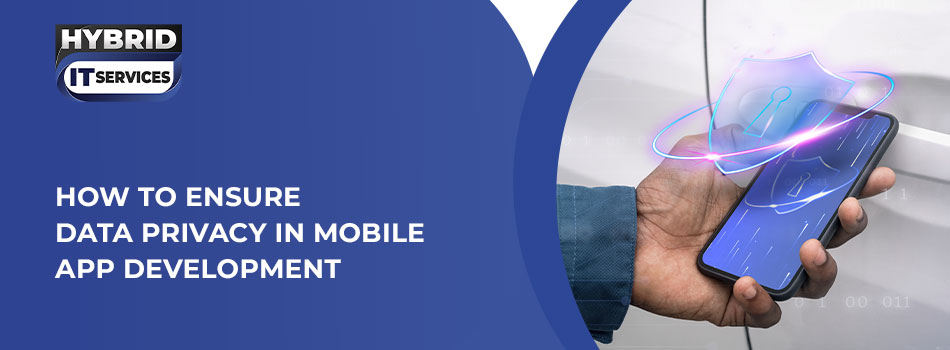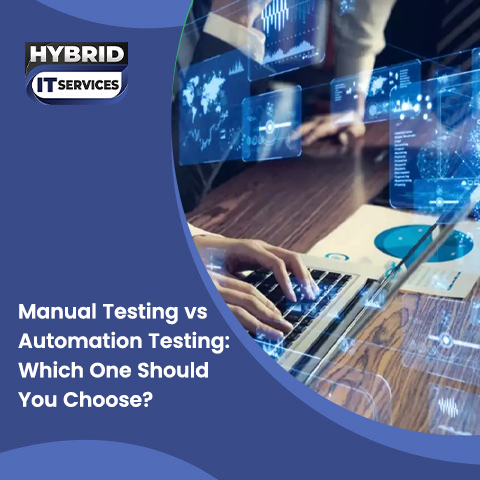Data privacy is paramount in the IT industry, especially as mobile apps collect an increasing amount of personal information. Users want assurances that their data is safe, and app developers are responsible for making that happen. At Hybrid IT Service, we'll explore the steps to ensure data privacy in mobile app development, covering everything from basic security measures to advanced encryption techniques.
Understand Data Privacy Laws and Regulations
Compliance with data privacy laws is one of the foundational aspects of protecting user data. Different regions have their own data protection laws, such as:
General Data Protection Regulation (GDPR) in the European Union.
California Consumer Privacy Act (CCPA) in California, USA.
Children's Online Privacy Protection Act (COPPA) for apps targeting children.
Understanding and incorporating these regulations into your app's design is essential to avoid legal issues and fines. These laws require transparency on how data is collected, stored, and used, so make sure your app has a clear privacy policy and provides users with options to control their data.
Use Data Minimization
Data minimization is a principle where you collect only the data necessary to fulfill the app's functions. For example:
If your app doesn’t require location data, avoid asking for it. Limit the storage of sensitive data to only what's required for functionality. This reduces the amount of data that could be potentially compromised and helps limit the impact in case of a data breach.
Implement Strong Authentication and Authorization Mechanisms
Authentication ensures that only authorized users can access the app, while authorization controls the access level each user has within the app.
Require a second form of verification, like a code sent to the user’s phone, to add an extra layer of security. Use these authorization protocols to give users secure access to data without storing passwords in your app. Also, consider using biometric authentication like fingerprints or facial recognition for apps handling sensitive data.
Encrypt Data Both at Rest and in Transit
Encryption is one of the most effective ways to protect data. By encrypting data, you convert it into a format that can only be read by someone with the right encryption key.
Data at Rest: This refers to data stored on the device. Use encryption methods like AES-256 (Advanced Encryption Standard) to secure user data stored on the device.
Data in Transit: Encrypt data when it’s being transmitted between the app and the server using SSL/TLS protocols. This ensures that data cannot be intercepted by third parties during transmission.
Secure APIs
APIs are crucial for mobile apps as they allow them to communicate with servers and other third-party services. However, APIs can also be vulnerable if not secured properly.
Only allow authorized applications to access your APIs by using secure tokens (like OAuth tokens) to control access. Implement rate limiting to prevent abuse by malicious users who might attempt brute-force attacks. Ensure that your APIs also follow secure coding practices, validating all inputs to prevent SQL injection and other forms of attack.
You May Also Read: Custom API Development: A Comprehensive Guide
Implement User Consent and Data Transparency
Data privacy is not just about security—it’s also about giving users control and transparency over their data. Make it clear to users why you need certain permissions or data.
When requesting access to sensitive information, make sure to explain why the app needs this data. Provide users with options to control what data they share and allow them to easily opt-out of data sharing. Include a clear privacy policy that describes how data is collected, stored, and used.
Adopt Secure Coding Practices
Secure coding practices help prevent vulnerabilities that could lead to data breaches. Key principles include:
Always validate user input to prevent injections and code manipulations. Never hard-code API keys or encryption keys within the app, as this makes it easier for attackers to extract them. The Open Web Application Security Project (OWASP) provides guidelines and best practices for mobile security, such as the OWASP Mobile Security Top 10 list, which highlights common security risks and mitigation techniques.
Use Secure Storage Solutions
When sensitive data needs to be stored on a mobile device, avoid using insecure storage methods.
Use Encrypted Databases (like SQLCipher) instead of plaintext databases to store sensitive information. Store sensitive information like user passwords or tokens in these secure storage options, which are specifically designed to protect sensitive data on mobile devices.
Regularly Update and Patch the App
Hackers constantly look for new vulnerabilities. Regularly updating your app helps patch any known vulnerabilities and protect user data from new threats.
Ensure that you apply patches for any security flaws discovered after release. Conduct regular code reviews and penetration testing to identify security weaknesses. Consider a bug bounty program or engage ethical hackers who can help identify issues before they become problems.
Conduct Regular Security Audits
A security audit is a thorough review of your app’s security measures. This can help identify vulnerabilities and ensure you are up to date with the latest security practices. Conduct periodic security assessments with your internal team. Employ external cybersecurity experts to conduct comprehensive security assessments, as they may identify issues that internal teams overlook.
You May Also Read: How Often Should You Update Your Mobile App?
Educate Users on Data Privacy
Users play an essential role in data privacy, too. Educate them on best practices to maintain security while using your app. Provide users with information on creating strong passwords, using two-factor authentication, and avoiding public Wi-Fi when using sensitive features. Encourage users to update their apps regularly to benefit from the latest security patches and features.
Consider Data Anonymization
If your app collects large amounts of data for analysis, consider data anonymization to enhance privacy. This involves transforming data so it cannot be linked back to individual users. Replace real data with fake but realistic data. Group data so that it reflects trends without revealing individual users’ data.
Conclusion
Data privacy is essential for building trust with your users and complying with laws. By following the practices outlined above, you can help protect user data and improve the overall security of your mobile app. Remember, data privacy isn’t just a one-time effort; it requires ongoing updates, audits, and attention to keep your app and users’ data safe in an evolving digital landscape.






